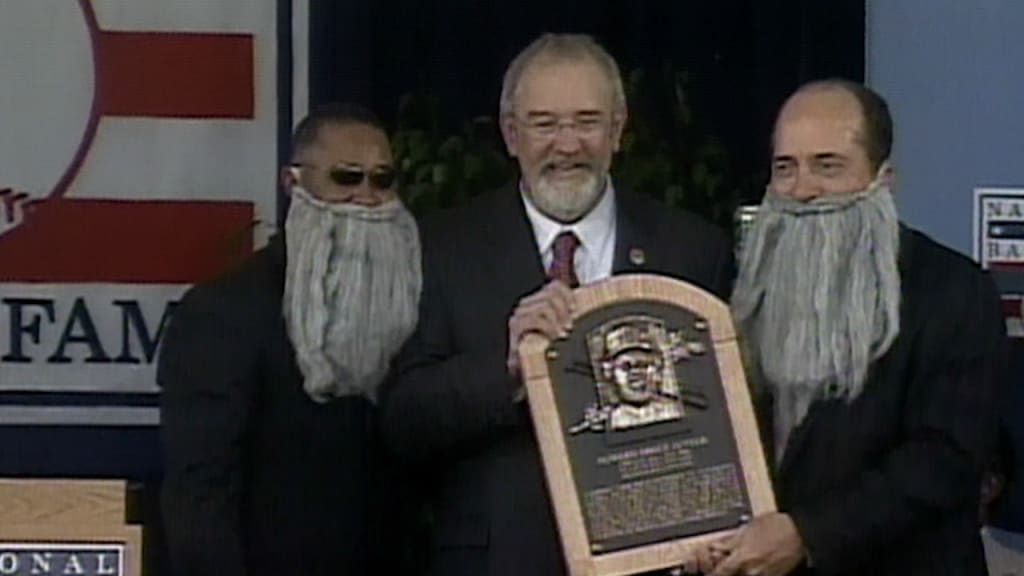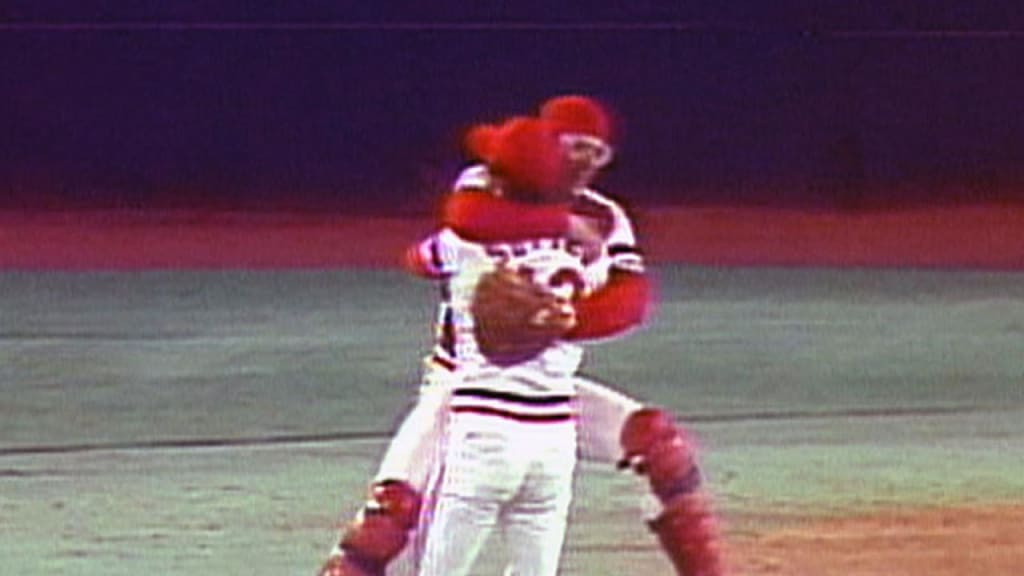10 moments that defined Sutter's career
This browser does not support the video element.
There are a few select bullpen forefathers who paved the way for baseball's era of late-inning specialization. Bruce Sutter, who passed away at 69, is on that short list of arms who blazed the trail for today's closers.
Sutter was a workhorse closer of the 1970s and '80s who, along with the likes of Rollie Fingers and Lee Smith, helped usher in a new way of thinking about utilizing relievers. He was a six-time All-Star, Cy Young recipient and World Series champion who is a franchise icon both for the Cubs and Cardinals.
In 2006, Sutter was immortalized when he was inducted into baseball's Hall of Fame, honoring a career full of incredible moments. Here are 10 that helped define Sutter's remarkable career.
1. World Series-clinching save
This was the moment the Cardinals dreamed about when they swung a blockbuster trade to acquire Sutter from the rival Cubs before the 1981 season. It was October of '82, and St. Louis was on the brink of World Series glory against the Brewers in Game 7 at old Busch Stadium.
Sutter picked up the win in Game 2 of the Series, but was shaky (even with one save secured) in Games 3 and 5, allowing four runs combined in those contests. In the final game, the big righty took the mound in the eighth with Paul Molitor, Robin Yount, Cecil Cooper and Ted Simmons looming.
"You couldn't think of a better ending to the World Series," Cardinals teammate Dane Iorg told the St. Louis Post-Dispatch after the game. "The best reliever in baseball against the best-hitting team in baseball. Your best against their best."
This browser does not support the video element.
Sutter set down Molitor, Yount and Cooper in order and returned to the hill in the ninth. After getting the first two outs via grounder, Sutter struck out Gorman Thomas with an outside heater that tailed back over the plate. Bedlam ensued. Catcher Darrell Porter jumped into Sutter's arms, and a mob of teammates, police and fans stormed the field.
"Darrell and I just rolled around on the bottom of the pile together," Sutter said after the Series clincher. "I'll be OK. I've got four months to heal."
2. Winning the Cy Young
The 1979 campaign may not have been Sutter's best season, but it was the one that ended with some well-deserved hardware. Sutter received 10 first-place votes in balloting for the National League's Cy Young Award, edging out 21-game winner Joe Niekro (nine first-place votes). That year, Sutter tied the then-MLB record for saves in one season (37) and ended with a tidy 2.22 ERA in 62 outings. The closer finished 56 games and ended with 110 strikeouts against 32 walks in 101 1/3 innings of work.
3. Setting the NL saves record
Sutter's dominance with the Cardinals continued in 1984, when the closer spun a 1.54 ERA in 71 appearances and a career-high 122 2/3 innings. Facing the Cubs on Sept. 28 that fall, Sutter secured his 45th save, tying the MLB record (set one year earlier by Kansas City's Dan Quisenberry) and establishing a new NL mark. In the final game of the season, Sutter had a chance to claim the Major League record for his own, but the closer flinched against his old club. The Cubs rallied for two runs in the bottom of the ninth on Sept. 30, leaving Sutter with 45 saves in another stellar year. He finished third in Cy Young voting and received MVP votes for the sixth time.
4. Save No. 300
Coming off his record '84 performance, Sutter signed as a free-agent with the Braves. Injuries marred his time in Atlanta, as he logged a 4.55 ERA with 40 saves in 152 1/3 innings total across 1985-88. On Sept. 9, 1988, Sutter toed the rubber in the big leagues for the final time in the 11th inning in San Diego. He recorded a flyout from Tim Flannery and then induced a groundout off the bat of Dickie Thon. For his final act in The Show, Sutter struck out an up-and-coming rookie star named Roberto Alomar, who was beginning his own Hall of Fame career. That save gave Sutter an even 300 for his career. That was the third-highest total in MLB history at the time for Sutter, who helped usher in a new era of late-inning specialization.
This browser does not support the video element.
5. Two All-Star Game saves
After picking up the win for the NL in both the 1978 and '79 All-Star Games, Sutter had consecutive saves for the Senior Circuit in '80 and '81. In the 1980 Midsummer Classic, Sutter worked the final two frames, ending the game with a strikeout of Lance Parrish. In '81, Sutter locked things down in the ninth, finishing off the American League with a flyout off the bat of Dave Winfield. Sutter was the first reliever in All-Star Game history to have saves in back-to-back years. Dennis Eckersley (1988-91) and Mariano Rivera (2005-06) later achieved the same feat. Overall, Sutter spun 6 2/3 shutout innings with seven strikeouts and only two hits allowed in his four All-Star appearances.
6. Two '82 clinchers
Closers can find themselves setting off celebrations late in campaigns for contending clubs. That was certainly the case for Sutter in the Cardinals' run to the playoffs and World Series in 1982. Before his championship-clinching save in Game 7 against the Brewers, Sutter was also on the hill for saves to clinch the division title (Sept. 27 against Montreal) and NL pennant (Oct. 10 in Game 3 of the NL Championship Series against the Braves).
This browser does not support the video element.
7. A brilliant '77 tour
Sutter's showing for the Cubs as a 24-year-old closer in 1977 was a taste of the dominance he would go on to display over a dozen seasons in the Majors. In fact, it was his career tour de force. Sutter and his splitter overpowered batters to the tune of a 1.34 ERA and 1.61 Fielding Independent Pitching. The 5.2 WAR (per Fangraphs) he compiled remains a single-season record for a reliever. Over 62 games, Sutter piled up 129 strikeouts and issued just 23 walks in 107 1/3 innings. The righty saved 31 games. Sutter was an All-Star and received votes for both the NL's Cy Young and MVP honors.
8. The first save
Before Sutter could even contemplate reaching 300 saves, he had to notch that first one. He made a scoreless MLB debut for the Cubs on May 9, 1976, and received his first save opportunity later that month. On May 23 in Pittsburgh, Chicago called on Sutter in the ninth after the Cubs grabbed a 6-5 lead in the top half of the frame. The first-time closer set down Bob Robertson, Rennie Stennett and Richie Hebner in order (each via a flyout) to seal the win, picking up career save No. 1 in the process.
This browser does not support the video element.
9. September of '82
The Cardinals entered Sept. 14, 1982, trailing their opponent that day, the Phillies, by a half-game for first in the division. In the eighth, it was a pair of future Hall of Famers -- Sutter and slugger Mike Schmidt -- squaring off with one out and the bases loaded. Sutter won the battle with a double-play groundout that put St. Louis on a path to a 2-0 win. That sparked an eight-game winning streak, sending the Cardinals on their way to the division crown. Sutter ended his September with a 0.00 ERA over his last nine outings, in which he piled up 14 1/3 innings, picked up a win and collected six saves.
10. Learning the split-finger
The moment that arguably propelled Sutter to a Hall of Fame career happened behind the scenes before he ever threw a pitch in the Majors. After an elbow injury marred his '72 season -- eventually necessitating surgery -- Sutter returned in '73 with a diminished fastball. Fred Martin, a Minor League pitching instructor with the Cubs, helped teach Sutter how to wield a split-finger fastball to give his arsenal a boost. The new toy became Sutter's signature weapon and confounded batters in an era before the splitter became more common in the big leagues.

